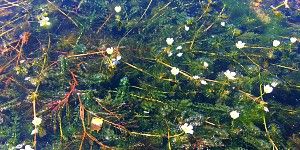Managing Plants, Algae, and Cyanobacteria in Your Private Pond
 Plants, algae, and cyanobacteria (blue-green algae) occur naturally in healthy aquatic ecosystems. Increases in plant and algal growth, or cyanobacteria blooms, due to excess nutrients may be considered a nuisance by private pond owners. The resources below will help you learn about what is growing in your pond, if it is healthy for pond ecosystems and human recreation, and provide options for managing your pond to maintain water quality and support healthy plant and algal growth.
Plants, algae, and cyanobacteria (blue-green algae) occur naturally in healthy aquatic ecosystems. Increases in plant and algal growth, or cyanobacteria blooms, due to excess nutrients may be considered a nuisance by private pond owners. The resources below will help you learn about what is growing in your pond, if it is healthy for pond ecosystems and human recreation, and provide options for managing your pond to maintain water quality and support healthy plant and algal growth.
Resources
-
Lake and Ponds Plant Booklet: This booklet explains the value of aquatic plants and how different species contribute to a healthy ecosystem. There is also information about how to identify if you have an aquatic nuisance plant issue. Before applying for an Aquatic Nuisance Control Permit, review this booklet to determine if the plant growth on your property is, in fact, a nuisance, or if it is healthy aquatic plant growth providing food and habitat to fish and wildlife.
-
What are Algae? This simple fact sheet about algae includes photos, definitions for different types of algae, and advice for preventing and reducing nuisance algae. As well as some information on Cyanobacteria.
- Cyanobacteria: Also known as blue-green algae, cyanobacteria is a group of native organisms that live in lakes, ponds, and rivers. You may be familiar with cyanobacteria blooms because some species of cyanobacteria produce toxins and therefore are a public health concern. The link above will take you to the DEC page “Cyanobacteria in Vermont,” where you can learn more on this topic. The Vermont Department of Health Recreational Water webpage also has information on cyanobacteria and health effects.
- A Key to Common Vermont Aquatic Plants: This key provides a simple step-by-step process so that anyone can easily identify aquatic plants.
-
Aquatic Nuisance Control Permit Program: If you are considering applying for a permit to control aquatic nuisance species, visit this page for more information. Depending on the method of management, a permit may be required.
-
Shoreland Best Management Practices: This page provides information, through the Lake Wise program, on green-infrastructure and shoreland vegetation options that promote healthy waterbodies by creating habitat, reducing erosion, and reducing pollution via run-off. These Best Management Practices will help pond owners maintain good water quality, aquatic habitat, fishing, swimming and bird watching.
-
Understanding and Evaluation Water Quality: This link will take you to a fact sheet on the Audubon International website. This 3-page document summarizes the sources and impacts of water pollution. Nutrient pollution may be contributing to your nuisance plant issue; this fact sheet will help you gain an understanding of what is causing nuisance growth in your pond.
